Best Places to Visit in Rajasthan in 2025
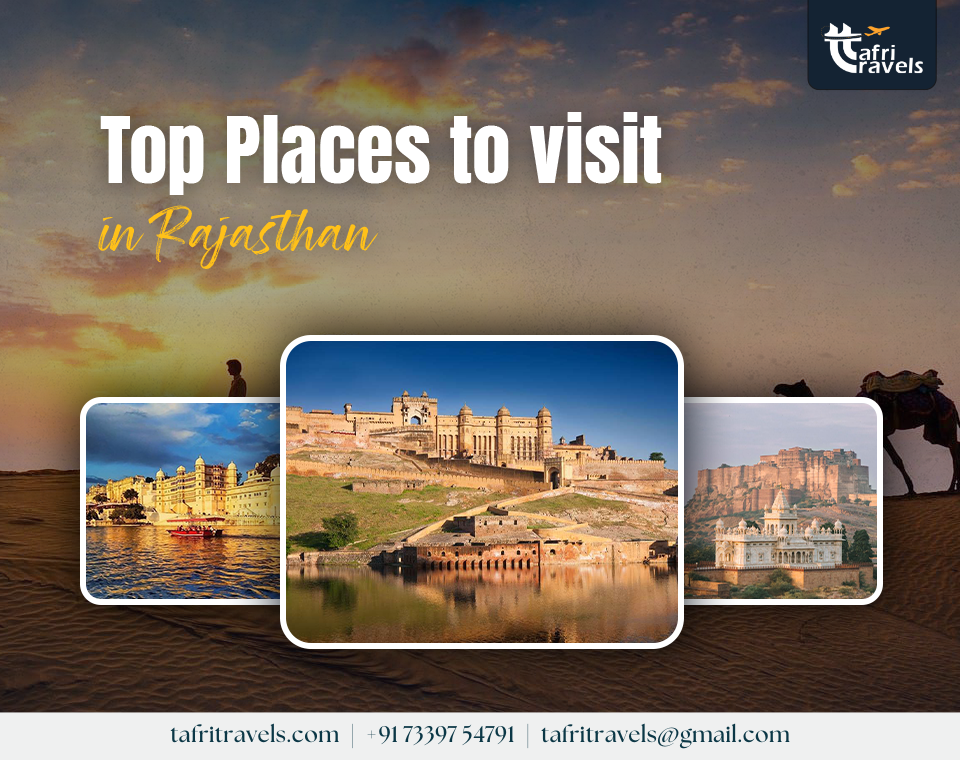
Best Places to Visit in Rajasthan in 2025
Rajasthan is a state that is situated in Northern India and covers 342,239 square kilometres or 10.4 per cent of India’s total geographical area. It is the largest Indian state by area and the seventh largest by population. This is the best state that describes the natural beauty of Rajasthani culture and modern tradition. It also tells us about the Best Places to Visit in Rajasthan, and we can plan our itinerary accordingly.
Table of Contents
ToggleTop Attractions in Rajasthan in 2025
Rajasthan, the land of royals, is a treasure trove of heritage, art, and natural beauty. From majestic forts to vibrant culture, it offers an unforgettable journey through India’s rich history. A must-visit in 2025!
1. Jaipur (The Pink City)

People call this place the capital of Rajasthan, a name that reflects the legacy of the royal family who once ruled the region. Jaipur slopes gently from north to south and then toward the southeast. The Nahargarh hills border it to the north, while Jhalana lies to the east. Today, people widely recognize Jaipur as the “Pink City,” a name earned from its distinctive architecture. The historical City Palace complex stands prominently at the center of the city’s elegant street grid. Jaipur is located 268 km from the national capital, New Delhi.
Highlights:
- We can explore the market for our regular shopping
- We can have an elephant ride to Amer Fort.
- Can explore the world’s largest stone-built observatory.
Must-visit places:
- Hawa Mahal: This location is a stunning pink facade, which stands as an architectural marvel. It is a charming landmark that enhances the beauty of Pink City.
- Nahargarh Fort: This place offers breathtaking panoramic views that boost a connection to the popular Jaigarh Fort, which makes it the most visited tourist spot.
- City Palace: The City Palace showcases a majestic complex spread across a series of courtyards. Mughal and Rajasthani architectural styles blend beautifully.
- Jantar Mantar: Rajput king Sawai Jai Singh, the founder of Jaipur (old name Sheherbagh), built Jantar Mantar—a remarkable collection of 19 astronomical instruments. This site features the world’s largest stone sundial.
- Amber Fort: Built with red sandstone and marble, Amber Fort stands on a hill and displays intricate artistic style elements. Today, it forms part of the Jaipur Municipal Corporation.
Read Full Guide: Places to Visit in Jaipur
2. Udaipur (The City of Lakes)
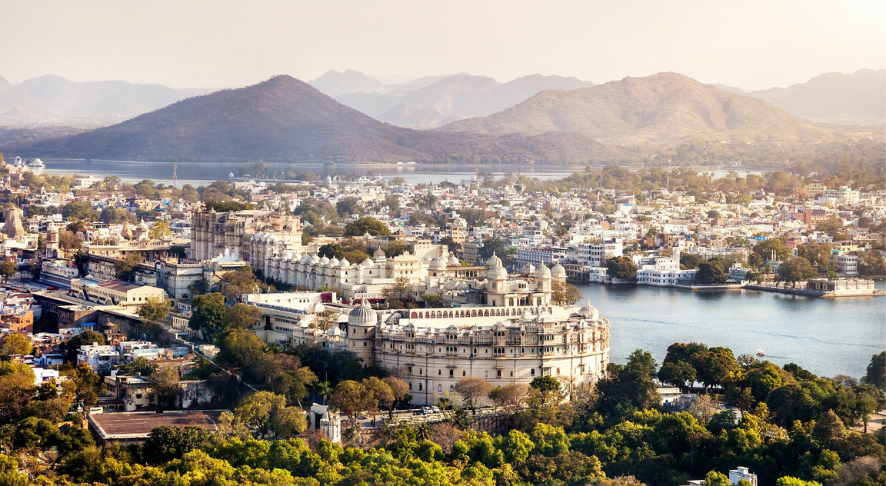
Maharana Udai Singh founded this city in the western Indian state of Rajasthan. Udaipur also once served as the capital of the Mewar Kingdom. The city features a stunning series of artificial lakes and is renowned for its royal residences. The famous City Palace, which overlooks Lake Pichola, is a monumental complex of green courtyards famed for its outstanding peacock mosaics. It is nestled in the corners of Rajasthan.
Highlights:
- Can explore the beautiful and serene lakes with the stunning lake view.
- Enjoy Rajasthani culture with the touch of modern tradition.
- Can explore the huge city palace.
Must-visit places:
- Lake Pichola: Located in the heart of Udaipur city, Lake Pichola is an artificial lake that showcases architectural beauty reflecting the city’s historical significance and royal heritage.
- Jagdish temple: This temple is one of the largest temples of Lord Vishnu and an architectural marvel that continues to be a landmark in Udaipur.
- Bagore ki Haveli: Situated in Udaipur, Bagore ki Haveli resembles an old mansion that now functions as a museum. Visitors can explore a rich collection of artifacts that highlight the region’s cultural legacy.
- Saheliyon ki baari: This place will surely look at a forest as it has a beautiful fountain with lots of green grasslands and a peaceful place to sit and relax.
- Karni Mata Temple: Here, we can seek blessings from Goddess Maa Karni and explore the temple by the Ropeway, among other things.
Read Full Guide: Places to Visit in Udaipur
3. Jodhpur (The Blue City)
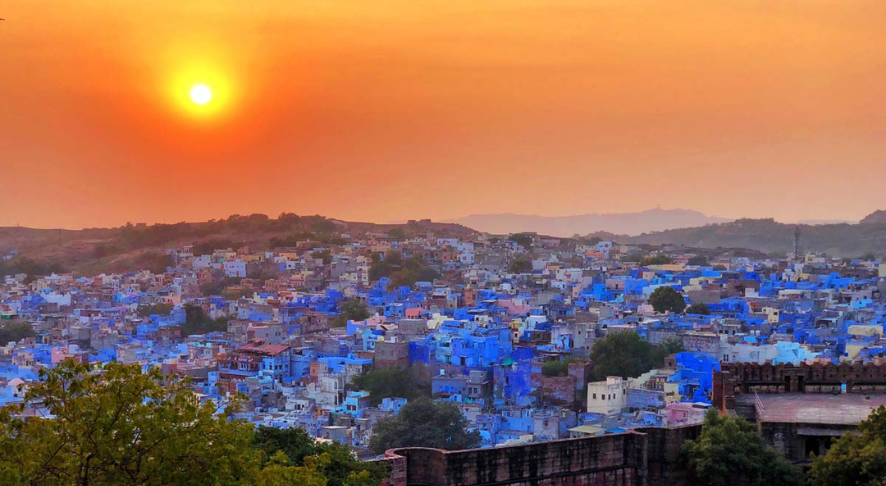
This city lies in the Thar Desert of northwest Rajasthan. The 15th-century Mehrangarh Fort, once a royal palace, now serves as a museum showcasing weapons and ornate royal palanquins. Perched on a rocky outcrop, the fort overlooks the walled city, where many buildings display the city’s iconic blue hue. Residents traditionally painted these homes blue to indicate that Brahmins—members of the priestly class—lived there.
Highlights:
- Can explore the beautiful blue city along the carved paintings on the wall.
- Can enjoy the stunning Lighting at Mandore.
- Can stop our cravings with the yummiest mirchi bada and Dahi-Kachori
Must-visit places:
- Mehrangarh fort: This place is majestically a rock hill, imposing the historical structures. Craftsmen carved many of its walls directly from rock and natural sediments, showcasing the fort’s raw architectural power.
- Jaswant Thada: It is a very charming and peaceful environment that I admire for its intricate architecture and the stunning views of the Blue city from its cenotaph of marble.
- Umaid Bhawan Palace: Maharaja Umaid Singh commissioned the construction of this architectural marvel. Today, it partially functions as a museum, where visitors can explore artifacts that reveal Jodhpur’s rich royal legacy.
- Old blue city: We can explore the beautiful blue city that wanders through the narrow in winding lanes by surrounding Mehrangarh Fort and creates a mesmerising glimpse in the locals.
- Toorji ka jaalra: Rao Jodha built this massive stepwell in the 15th century. Today, it stands as a popular historical landmark in Jodhpur, admired for its heritage and intricate design.
Read Full Guide: Places To Visit In Jodhpur
4. Jaisalmer (The Golden City)
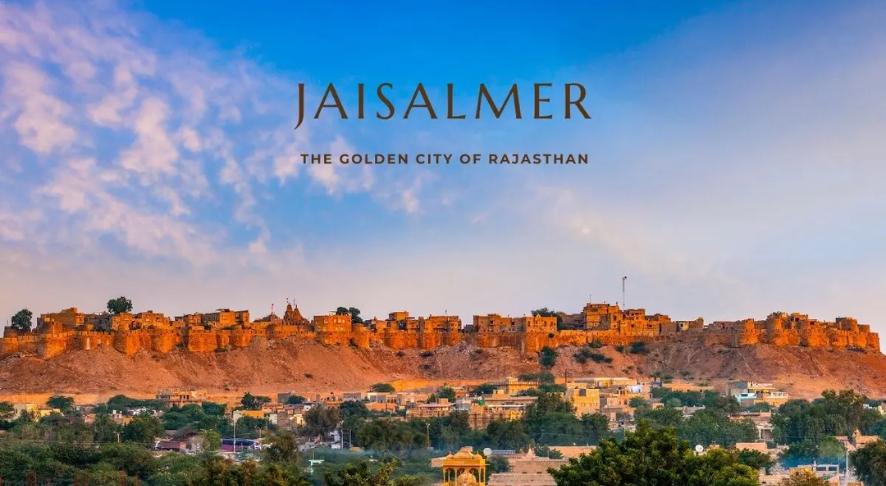
People often call Jaisalmer the “Golden City” because of its stunning architecture and rich cultural heritage. Located in Rajasthan, India, the city sits in the heart of the Thar Desert. Its yellow sandstone buildings gleam under the desert sun, giving Jaisalmer its iconic golden glow. The city’s main point of attraction is the Jaisalmer Fort, a UNESCO World Heritage Site, where many people work. It has a fascinating history, having served as the capital of a kingdom, reflected in its traditional festivals and music.
Highlights:
- Go on an enjoyable camel safari into the Thar Desert.
- Can explore the huge fort of Jaisalmer along with havelis and mansions.
- Expereince the Sam Sand Dunes.
Must-visit places:
- Jaisalmer havelis: This is the best place to explore the historical carved havelis of Jaisalmer, which tell a tale of craftsmanship that dates back to the bygone era of Rajputana.
- Jaisalmer Fort: This location rises majestically from the desert landscapes to immerse ourselves in its narrow valleys and witness the fusion of architectural marvels.
- Thar desert: we can immerse ourselves in the desert safari to the sam dunes for a wonderful experience, as the sun sets, they come alive with a mesmerizing play of colours.
- Gadisar lake: Local rulers built Gadisar Lake as a man-made reservoir, surrounding it with ghats and a temple. Visitors can enjoy a peaceful boat ride while soaking in the serene natural beauty.
- Bada Bagh: Also known as Barabagh, Bada Bagh is a historic garden complex situated about six kilometers north of Jaisalmer. It was developed to bring green space into the otherwise arid desert landscape.
Read Full Guide: Places to Visit in Jaisalmer
5. Pushkar (The Sacred Lake Town)
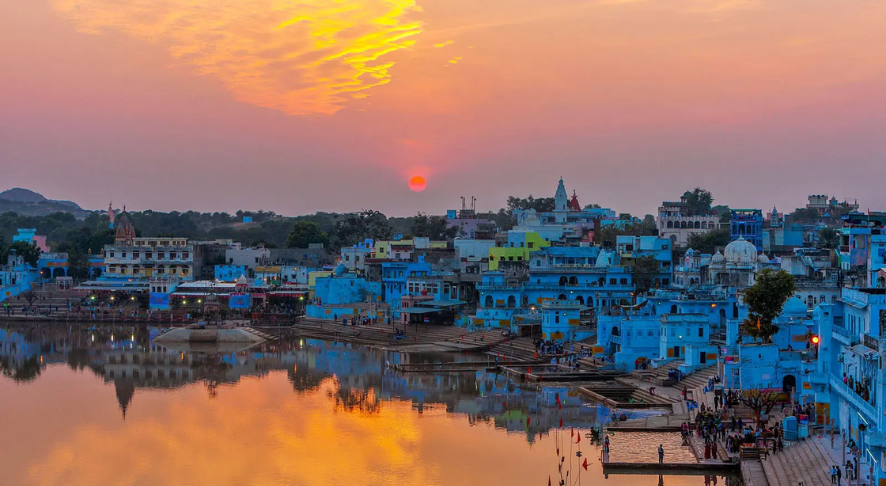
Pushkar, a temple town near Ajmer City, serves as the headquarters of Pushkar tehsil in the Ajmer district of Rajasthan, India. Located about 10 km northwest of Ajmer and around 150 km southwest of Jaipur, Pushkar attracts countless pilgrims every year. Pushkar Lake, surrounded by 52 bathing ghats, draws large crowds, especially during Kartik Poornima, when devotees gather for a sacred bath during the famous Pushkar Fair.
Highlights:
- Can visit the unique Brahma Temple and Savitri Temple.
- Head to Pushkar Lake, which looks very pretty in the evening.
- Enjoy the largest Camel Mela in Pushkar.
Must-visit places:
- Pushkar ghats: The serene ghats of Pushkar lie along the peaceful waters of Pushkar Lake. Numerous temples and bathing steps enrich the surroundings, inviting pilgrims to take part in sacred rituals by the ghat.
- Brahma temple: Devotees visit the Brahma Temple, one of the few prominent temples dedicated to the creator of the universe. The temple showcases striking architecture and intricate sculptures that captivate visitors.
- Savitri temple: this is the best temple that offers panoramic views to this scared site that goes with the breathtaking vistas of nearby landscapes.
- Pushkar camel fair: this is a must-attend annual fair that transforms the place into vibrant spectacle that covers all the cultural events and the lively marketplace.
- Varaha temple: Located just 500 meters from Pushkar, the Varaha Temple honors Lord Vishnu’s Varaha avatar. Built in the 15th century, the temple reflects a rich history and deep spiritual significance.
Read Full Guide: Places to Visit in Pushkar
For Free Consultation
Contact Number: +91 8107871710
Email: tafritravels@gmail.com
6. Bikaner (The Desert Trading Hub)

This is the old city in Rajasthan, India, which was historically a major desert trading hub due to its outstanding location on caravan trails and its flourishing camel trade. The city was founded by Rao Bika in 1486, and he invited Marwadi merchants to build their havelis, contributing to Bikaner’s growth. Now, Bikaner is famous for its rich heritage and vibrant traditions, like the Camel Festival. This place was a center for the camel trade, facilitating trade between Indian merchants and merchants from other countries.
Highlights:
- Can look at the alternative Thar desert and camel treks.
- Seek blessings at the Karni Mata temple, about 20 km from the main city.
- Explore the Junagarh Fort along with diverse artifacts.
Must-visit places:
- Karni Mata Temple: Locals revere this unique temple as the sacred home of thousands of rats. Devotees visit to seek blessings and witness the rats freely roaming throughout the temple premises.
- Junagarh fort: This is a formidable fort that is an architectural masterpiece that beautifully explores its intricately designed palaces, which echo the glory of Bikaner’s royal past.
- Lalgarh Palace: The royal family constructed this palace in the Indo-Saracenic architectural style. It features ornate designs and displays an impressive collection of hunting trophies.
- Ratan Bihari Temple: Builders relocated this stunning temple to its current location in the 19th century. Today, it adds architectural charm and spiritual depth to the city’s landscape.
- Sursagar lake: A towering statue of Lord Shiva rises above the lake, illuminated beautifully during Maha Shivaratri. The site serves as a vibrant spiritual and visual landmark for visitors.
Read Full Guide: Places to Visit in Bikaner
7. Ajmer (The Spiritual Crossroads)
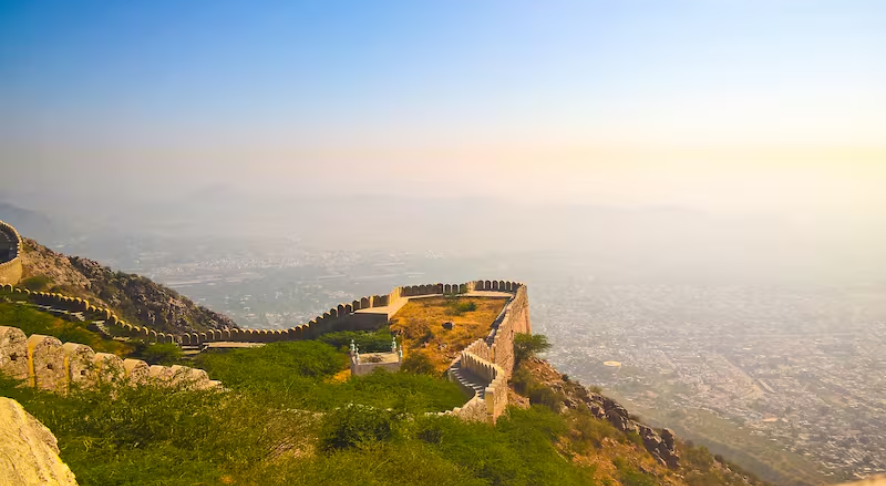
This is the city that is nestled in the heart of Rajasthan, and is a captivating blend of history and culture. Notably, it is one of the most important pilgrimage destinations in India, drawing thousands of visitors each year seeking spiritual enlightenment—from the famous Ajmer Sharif Dargah to the tranquil Ana Sagar Lake. Whether you want to explore history or are simply in search of a unique cultural adventure, Ajmer undoubtedly promises a journey like no other.
Highlights:
- Can hike up to the Taragarh, which is very popular.
- Can visit the Tomb of Khwaja Muin-ud-din Chisti, the main reason for coming here.
- Can visit the mango masala restaurant at the locals.
Must-visit places:
- Ajmer Sharif Dargah: It is a beautiful pilgrimage site and it is the tomb of the Sufi saint Khwaja Moinuddin Chisti, which devotees from various faiths visit to witness these styles.
- Adhai Din Ka Jhopra Museum: this place was purely open to the historical layers, which once served as a Sanskrit college to provide a glimpse into the city’s past.
- Taragarh fort: Builders constructed this fort on a steep hillside, valuing its strength and strategic location. Its scale and design gave it the appearance of a grand palace.
- Soniya Ji Ka Nasiya Jain Temple: Devotees built this temple in honor of Lord Adinath, making it one of the most prominent religious sites in Ajmer. It stood as the oldest Jain temple of its time.
- Anasagar Lake: The lake takes its name from its founder, who created it in the 12th century by building a dam across the Luni River. As an artificial lake, it remains a significant historical and scenic spot.
Read Full Guide: Places to Visit in Ajmer
8. Chittorgarh (The Land of Valor)

This place evokes vivid images of the glorious sacrifices made by the Rajputs and reflects their enduring spirit of freedom and honor. Strategically positioned, the fort carries the legacy of the Rajput chiefs collectively known as the Maharanas. The Chittor fort stands out among the forts of India for its rare historical importance, which holds the key to the history of medieval Rajasthan. The fort has high rocks on three sides, crowned with temples and trees, which surround the whole palace.
Highlights:
- Can visit the Vijay-stambh, a nine-story tower adorned with intricate carvings.
- Dive into the luxurious Fateh Prakash Palace.
- Explore the famous and largest Chittorgarh Fort.
Must-visit places:
- Chittorgarh fort: This is a world heritage site, and it is popular for its rich history, immersive architecture, and lots of cultural sites and towers.
- Meera temple: Rana Kumbha built this temple in honor of Meera Bai, the famous poetess known for composing devotional music and bhajans.
- Vijay Stambh: The Rajputs erected this victory monument within the Chittor Fort. Its narrow, towering structure leaves a striking impression on visitors.
- Jauhar Palace: The Rajputs constructed this palace to serve as the site for the act of Jauhar—a ritual of mass self-immolation performed by women to protect their honor during invasions.
- Gaumukh kund: This historic water reservoir lies within the Chittor Fort complex. Visitors recognize it not only for its connection to royalty but also for its spiritual significance, especially near the Meera Temple.
9. Bundi (The Hidden Gem)
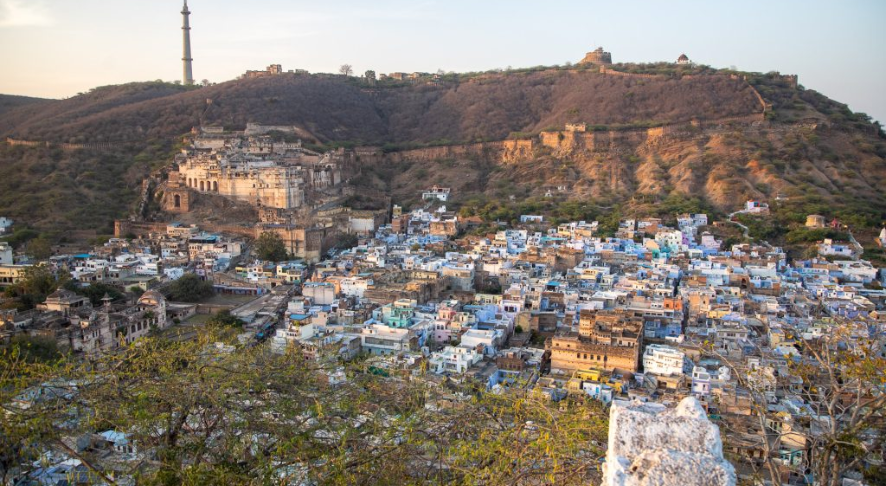
Bundi became the crown jewel of my months-long solo backpacking journey across Rajasthan. Far from the usual tourist crowds in major cities, this hidden gem offers every regal detail a traveler could hope for. Surrounded on three sides by the Aravalli Range and nestled near a narrow gorge, Bundi showcases stunning architectural grandeur—its ornate palaces and intricately carved stepwells leave visitors in awe.
Highlights:
- Can climb up to the hilltop fortifications of the Taragarh.
- Can visit the famous Palace.
- Dive into Chitrashala – a beautiful art gallery.
Must-visit places:
- Garh Palace: here we can explore the amazing view of garh palace to see the royal heritage and admire the panoramic views of the beautiful town.
- Nawal Sagar: Surrounded by the Aravalli hills, this artificial lake stands out with a partially submerged structure in its center, creating a picturesque and serene view.
- Taragarh fort: Perched atop a hill, Taragarh Fort invites travelers to explore its mysteries. The fort features well-preserved reservoirs and offers a fascinating glimpse into Rajput history.
- Sukh Mahal: Located in the heart of the city, Sukh Mahal is a historical structure famously linked to Rudyard Kipling, who is believed to have drawn inspiration from its peaceful surroundings.
- Raniji ki Baori: This large stepwell dazzles with its intricate carvings and perfectly symmetrical design, offering a blend of artistic beauty and nighttime reflections that captivate every visitor.
10. Mount Abu (The Hill Station)
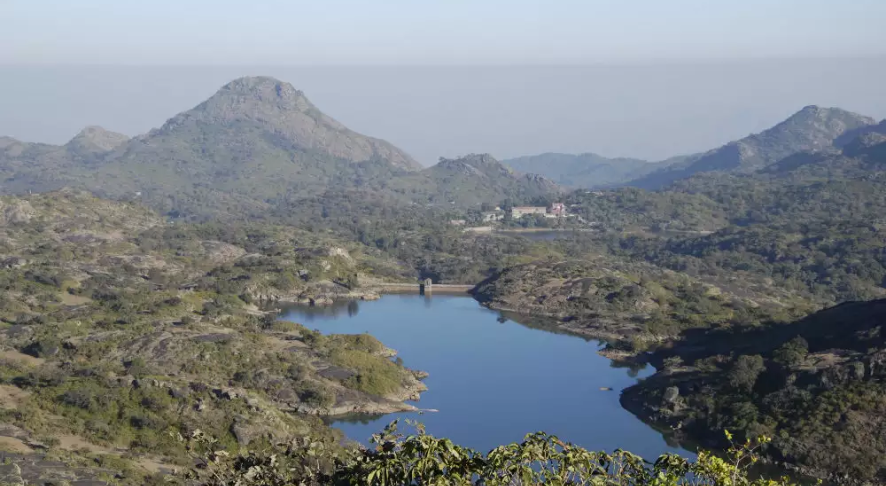
This place is a popular hill station in Rajasthan, India, popular for its lush greenery, temples, and it is situated in the Aravalli Range, often called “an oasis in the desert” due to its unique climate and scenery. The hill station is a popular retreat from the hot weather of Rajasthan and neighboring Gujarat, and the area is the Sirohi district of Rajasthan, near the border with Gujarat.
Highlights:
- Enjoy the cool climate with picturesque surroundings.
- Experience the different adventurous sports and other activities.
- Take the view and feel of green grasslands and lush mountains.
Must-visit places:
- Dilwara temple: it is the popular jain temple that boasts the aesthetic marble carvings showing the rich and culture architectural styles.
- Toad rock: This is a rare rock formation with a beautiful panoramic view that distinguishes the stunning layout of rock and sediments.
- Nakki Lake: This is a man-made reservoir which is surrounded by large hills and holds cultural significance with tales of mythology.
- Sunset point: this point is located just 2 km away from the famous Nakki Lake where we can enjoy the picturesque surroundings to capture the sunset.
- Trevor’s tank: This is a small dammed lake in the heart of Mount Abu wildlife sanctuary, named after the British Colonel, amidst the natural species.
Read Full Guide: Places to Visit in Mount Abu
Cultural Highlights of Rajasthan
Rajasthan stands as the royal territory that weaves together its majestic forts alongwith traditional heritage. Every area of Rajasthan showcases the deep cultural legacy which includes royal palaces along with flavorful cuisine and traditional music with folk dances. Each experience reveals unique tales so people can explore this timeless charm of Rajasthan.
1. Folk Music and Dance
The folk music together with dance in Rajasthan, represent a heartfelt display of both cultural diversity and royal traditions. Every musical and dance performance within Rajasthan includes Panihari and Maand. They also feature Ghoomar and Kalbelia dances, which depict stories about love and devotion. The local artists enhance mortality of traditions by dressing in colorful clothing while wearing traditional jewellery. They bring alive centuries of heritage that captivates current generations. Each musical note from the instruments including the sarangi, the dholak and the algoza brings a traditional appeal to each performance.
2. Traditional Arts and Handicrafts
Rajasthan is a notable state in India for its handicrafts and arts which still maintains the beauty and tradition of Rajasthan. Its Ethnic arts include block printing, tie and dye, pottery and miniature paintings, these arts reflects the old cultural heritage. Meanwhile, to preserve the ancient culture of Rajasthan, local residents of Rajasthan still make traditional handicrafts it contains carpets, jewellery ornaments, Lac bangles, garments and pottery.
3. Forts of Rajasthan
Rajasthan is a symbol of bravery and courage, and it is also called a battlefield, as it was the land of kings with magnificent forts that narrate stories about valorous royalty and historical heritage. Furthermore, the Rajput architectural heritage shines through the golden Jaisalmer Fort walls, as well as the Chittorgarh hilltop complex and the Jaipur Amer Fort with its royal appearance. Moreover, the forts gained more attention than monuments, since they exist as living legends that surround themselves with huge boundaries and historic battles, while also presenting stunning vistas.
4. Cuisines
The food of Rajasthan presents royal tastes accompanied by old traditional culinary customs. Dishes like Laal Maas and Dal Baati Churma represents a rich cultural heritage of rajasthan. The desert teraains of rajasthan made Gatte ki Sabzi along with Ker Sangri and Papad ki Sabzi because these dishes use minimal water to achieve maximum taste. Rajasthani banquet are enhanced with traditional sweets consisting of Ghewar and Mawa Kachori that brings memorable culinary experiences.
5. Festivities
Rajasthan become a spectacular state due to its vibrant festivals and their alluring ambience. These traditional and royal festivals showcases historical roots of rajasthan culture. The state offer both woman-centered events such as gangaur and teej and the jaisalmer desert festival that brings wave of happiness for all visitors. The state celebrates Diwali with the illumination of forts and havelis and Holi creates a beautiful and colorful spectacle throughout Rajasthan.
Shopping Guide
1. Bandhani textiles
It is a type of tie-dye textile decorated by plucking the cloth with the fingernails into several bindings that form a figurative design.
2. Kundan jewelry
This kind of jewellery is a form of jewellery made from gold, usually with a core of wax. The term ‘kundan’ itself means highly refined pure gold, and this type of jewellery generally consists of 24-k gold.
3. Camel leather products
These products are a bright tan color with an unusual, uniform texture that tends to have small grain patterns, and they are very durable and strong.
4. Blue pottery
This is a unique form of pottery originating in Jaipur, Rajasthan, characterized by its distinctive blue color, achieved through the use of cobalt oxide.
Best Places to Visit in Rajasthan- Suggested routes:
1. Golden Triangle (Jaipur-Udaipur-Jodhpur)
The “Golden Triangle” with Jodhpur and Udaipur is one of the famous Indian travel routes that combines the iconic cities of Jodhpur, Udaipur, and Jaipur with the just by offering a diverse cultural experience. This tour, often lasting 8-10 days, allows several travelers to explore ancient monuments, vibrant markets, and unique cultural landscapes that purely describe nature’s beauty.
2. Desert Circuit (Jaisalmer-Bikaner).
The Desert Circuit in Rajasthan—often referred to as the Desert Triangle—offers travelers a captivating journey through the Thar Desert, connecting the cities of Jaisalmer, Bikaner, and beyond. This popular tourist route highlights the region’s vibrant culture, rich history, and dramatic landscapes. Travelers admire Jaisalmer, known as the “Golden City,” for its magnificent Jaisalmer Fort, a UNESCO World Heritage Site, and its beautifully carved havelis.
Conclusion
Rajasthan, India’s largest state, proudly earns its title as the “Land of Kingdoms.” The state showcases a wealth of forts and historical landmarks that continue to captivate global travelers. From breathtaking sand dunes to majestic royal ruins, Rajasthan offers a rich tapestry of history and culture. It draws visitors to explore its many diverse attractions. These Places to Visit in Rajasthan not only amuse history buffs but also inspire local visitors and tourists alike. Their scenic charm invites exploration of Rajasthan’s beauty.
FREQUENTLY ASKED QUESTIONS
1. What are the must-visit attractions in Rajasthan for first-time travelers?
Ans: First-time visitors should explore Jaipur’s Amber Fort, Udaipur’s City Palace, Jodhpur’s Mehrangarh Fort, Jaisalmer Fort, and the sand dunes of Thar Desert. Don’t miss Pushkar for its spiritual charm and Bikaner for its heritage havelis.
2. When is the best time to visit Rajasthan?
Ans: The best time to visit Rajasthan is from October to March, when the weather is cool and ideal for exploring forts, palaces, and deserts. It’s also the season for many cultural festivals and fairs.
3. Are there any offbeat or hidden places to explore in Rajasthan?
Ans: Yes! Explore offbeat gems like Bundi’s stepwells, the leopard safari in Jawai, Banswara’s lush greenery, and the blue-painted streets of Brahmpuri in Jodhpur. Chand Baori in Abhaneri is another underrated marvel.
4. What unique experiences should tourists not miss in Rajasthan?
Ans: Experience a camel safari in Jaisalmer, boating on Udaipur’s Lake Pichola, hot air ballooning in Jaipur, and attending folk performances in desert camps. Also, indulge in traditional Rajasthani cuisine and shop for local handicrafts.
5. How many days are enough to explore Rajasthan fully?
Ans: A well-rounded trip to Rajasthan typically takes 7–10 days, covering major cities and a few hidden gems. Shorter trips of 3–5 days can focus on specific regions like Jaipur-Udaipur or Jodhpur-Jaisalmer.
15 thoughts on “Best Places to Visit in Rajasthan in 2025”
Add a Comment Cancel reply

[…] Read Also: Best Places to Visit in Rajasthan […]
[…] Read Also: Best Places to Visit in Rajasthan […]
[…] Read Also: Best Places to Visit in Rajasthan […]
[…] Read Also: Best Places to Visit in Rajasthan […]
[…] Read Also: Best Places to Visit in Rajasthan […]
[…] Read More: Best Places to Visit in Rajasthan […]
[…] Read Also: Best Places to Visit in Rajasthan […]
[…] Read Also: Best Places to Visit in Rajasthan […]
[…] Also Checkout: Best Places to Visit in Rajasthan in 2025 […]
[…] Take The Full Tour On:- Best Places to Visit in Rajasthan in 2025 […]
[…] Plan Your Trip: Best Places to Visit in Rajasthan in 2025 […]
[…] See what’s inside: Best Places to Visit in Rajasthan in 2025 […]
[…] Plan Your Trip: Best Places to Visit in Rajasthan in 2025 […]
[…] Plan Your Trip: Best Places to Visit in Rajasthan in 2025 […]
[…] Wander into Royal Wonder: The Best Places You Must Visit in Rajasthan in 2025 […]